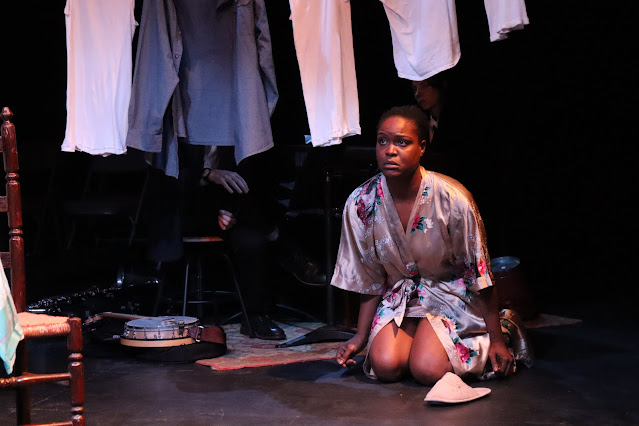The Climate Fables: The (Green Apple) Play
Written by Padraig Bond
Directed by Jess Lauricello
94 St. Marks Place, Manhattan, NYC
October 13-15, 2024
 |
| Pedro Vierre and Anabella Pritchard |
With just this past week in the United States seeing not only further storm-caused devastation linked to anthropogenic climate change but also threats of violence against government aid workers responding in the aftermath,
The Climate Fables, from theater company Torch Ensemble, only grow more timely and the socioecological issues with which they grapple more urgent.
The Climate Fables, written by playwright Padraig Bond, will eventually comprise a classical-epic-length twelve plays, and
The (Green Apple) Play is the most recent production in both this cycle and in Torch Ensemble's
residency at FRIGID New York, with
The Climate Fables: Coyote Oughta Eat That Salesman! to follow in late January 2025.
The (Green Apple) Play–the first
Climate Fable that Bond wrote, during the early stages of the pandemic in April 2020–slots into
The Climate Fables' millennium-long timeline at some point after the events of the previously staged
Fable,
Ogallala, in which a human city by that name is rising in the post-climate-apocalypse future and offering a chance to do things differently this time.
The (Green Apple) Play, which suggests that Ogallala is at this juncture bending back towards the same sort of practices and systems (including the recent reintroduction of waged labor) that led to catastrophe in the first place, finds a group of humans hunting for resources in a forest that is inhabited by a witch who is mother to a forest god, with results that are literally nightmarish yet retain a space for hope and transformation.
 |
| L to R: Sam Alexander, Jennie Reich Litzky, Kai Barbee, Julia Winer |
The Witch (Annabella Pritchard) acts simultaneously as a character within the play and as its presenter, framing the play as a play, including by promising us nine scenes which are duly tracked by the characters as part of the set design. The parentheses in the play's title gesture to this
mise en abyme aspect, while perhaps also hinting at the rounded sides of an apple. That the titular apple is green might be seen to refer to "green" as an ecological shorthand–and the color stakes a strong presence from the start in the costume and set design–but it can also evoke unripeness, appropriate not only to a young forest, which the Witch tells us has only been able to grow with the help of magic, but to the young god (Pedro Vierre) or forest spirit who resides there. This god will be less of an innocent by the time that the play ends, with Vierre making the corresponding transition from childlike to imposing with aplomb. The group from the city with whom he and the Witch eventually cross paths–led by a Merchant (Samson MacDermot) and including a Woodcutter (Sam Alexander), a Naturalist (Jennie Reich Litzky), a fisher (Julia Winer), a Miner (Kai Barbee), and a Trapper (Fara Faidzan)–are familiar, with the witch, as a folktale which they have heard since childhood (the admonition to the group from the Naturalist, who hasn’t heard the tale and doesn’t believe in witches, to pay attention to the problems in front of them rather than worrying about a fictional construct merits our attention, even if she is wrong about the Witch). Indeed, the register here is heavily folkloric (the Witch, in her atypical position as teller rather than object of such tales, even spells out her didactic purpose), as in the overwhelming absence of individual proper names for the characters, even as a scene in which several of them disagree over the witch’s story identifies her with a character whom we have met in previous Fables. (It may not be too much of a stretch to discern some echoes of
A Midsummer Night’s Dream and
The Tempest here as well.) The Merchant has also brought along a Soldier (Sydney Gerlach), which makes the Naturalist nervous from the first and reflects the fact that the Merchant may not have the best intentions. The Merchant too is interested in mythologizing and wants his own story to be told as one of violent heroism, a conquering of nonhuman nature that is suitably atavistic for a figure who can represent our own Capitalocene era. In the end, the humans who enter the forest will have to make a choice whether or not to align themselves with the Merchant and all that he represents.
 |
| Samson MacDermot and Jennie Reich Litzky |
The production features ample humor, and the various human specialists are charmingly idiosyncratic, from Winer’s Fisher who doesn’t actually want to ever catch a fish to Faidzan’s excellent turn as the Trapper, who displays the kind of heroism that someone like the Merchant could never match. Things do get dark, as in the Fisher’s discussion of feelings of shame for merely existing (the sort of “climate grief” not widely depicted in pop culture) and especially in a fantastically staged late scene in which the god infiltrates the humans’ dreams, a scene that also showcases the production’s great use of sound, from the crackling of flames or the stomping of the cast’s feet to the rhythm of the nightmares that the god conjures to his disembodied voice and beyond. MacDermot is an effectively confident, self-regarding villain, and Pritchard is compellingly multidimensional as the Witch, whether she is directly engaging the audience, fighting off a gun-wielding foe, or comforting an injured spirit of the forest. Ultimately, the apple in
The (Green Apple) Play represents not forbidden but vital knowledge, and the spell in which the witch climatically leads us may not be literal witchcraft, but there is magic and, one hopes, power in such a collective incantation nonetheless.
-John R. Ziegler and Leah Richards
Review of The Climate Fables: Debating ExtinctionReview of The Climate Fables: The Collapse of the Hubbard GlacierReview of The Climate Fables: OgallalaReview of The Climate Fables: The Trash Garden






Comments
Post a Comment